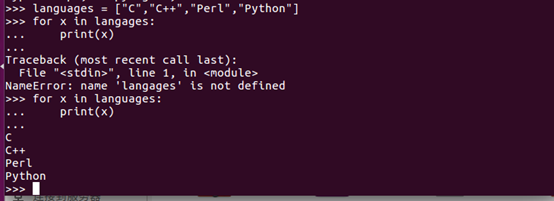Python中while語句的一般形式:
while 判斷條件:
?????? 語句
?
同樣需要注意冒號和縮進,另外在Python中沒有do…while循環
下面的實例計算1到100總和
##calc.py n = 100sum = 0 counter = 1 while counter <= n:sum = sum + countercounter += 1print("total from 1 to 100 : %d",sum)
運行結果:
robot@ubuntu:~/wangqinghe/python/20190826$ python3.5 calc.py
total from 1 to 100 : %d 5050
?
while循環中使用else語句
在while…else在條件語句為false時執行els語句塊
#while.py count = 0 while count < 5:print(count," < 5")count = count + 1 else :print(count ," >= 5")
運行結果:
robot@ubuntu:~/wangqinghe/python/20190826$ python3.5 while.py
0? < 5
1? < 5
2? < 5
3? < 5
4? < 5
5? >= 5
?
for循環:
Python for循環可以遍歷任何序列的項目,如一個列表或一個字符串
for循環的 一般格式如下
for <variable> in <sequence>:<statement> else:<statement>
實例:

break語句用于跳出當前循環體:
##break.py sites = ["Baidu","Google","Runoob","Taobao"] for site in sites:if site == "Runoob":print("cainiao!")breakprint("loop data " + site) else:print("Having no loop data!") print("loop end!")
運行結果:
robot@ubuntu:~/wangqinghe/python/20190826$ python3.5 break.py
loop data Baidu
loop data Google
cainiao!
loop end!
range()函數
如果你需要遍歷數字序列,可以使用內置的range()函數,它會生成數列,例如:
?
?
也可以使range以指定數字開始并指定不同的增量,(甚至可以是負數,有時這也叫步長)
?
??
負數:
?
?
也可以結合range()和len()函數以遍歷一個序列的索引:
?
?
?
還可以使用range()函數來創建一個列表:
?
?
?
break和continue語句及循環中的else子句
break語句可以跳出for和while循環體,如果你從for或while循環終止,任何對應的循環else塊將不執行:
#else.py for letter in 'Runoob':if letter == 'b':break;print('the current letter : ',letter)print("the next example")var = 10 while var > 0:print('the current variable : ',var)var = var - 1if var == 5:break; print("GOOF bye!")
運行結果:
robot@ubuntu:~/wangqinghe/python/20190826$ python3 else.py
the current letter :? R
the current letter :? u
the current letter :? n
the current letter :? o
the current letter :? o
the next example
the current variable :? 10
the current variable :? 9
the current variable :? 8
the current variable :? 7
the current variable :? 6
GOOF bye!
?
continue語句被用來Python跳出當前循環塊的剩余語句,然后繼續下一輪循環。
循環語句可以有else子句,它在窮盡列表(for循環)或條件變為false(以while循環)導致循環終止時被執行,但循環被break終止時不執行。
下列是查詢質數的循環例子:
##prime.py for n in range(2,10):for x in range(2,n):if n % x == 0:print(n," == ",x, '*', n//x )breakelse:print(n," is prime")
運行結果:
robot@ubuntu:~/wangqinghe/python/20190826$ python3 prime.py
2? is prime
3? is prime
4? ==? 2 * 2
5? is prime
6? ==? 2 * 3
7? is prime
8? ==? 2 * 4
9? ==? 3 * 3
?
pass語句
Python pass是空語句,是為了保持程序結構的完整性。
pass不做任何事情,一般用作占位語句:
#pass.py for letter in 'Runoob':if letter == 'o':passprint('execute pass block')print('the current letter : ',letter)print("Good bye!")
運行結果:
?robot@ubuntu:~/wangqinghe/python/20190826$ python3 pass.py
the current letter :? R
the current letter :? u
the current letter :? n
execute pass block
the current letter :? o
execute pass block
the current letter :? o
the current letter :? b
Good bye!
?
pass只是為了防止語法的錯誤
pass就是一條空語句,在代碼段中或定義函數時,如果沒有內容,或者就先不做任何處理,直接跳過,就可以先使用pass
?
十進制轉換:
#translate.py while True:number = input('please input a integer(enter Q exit ):')if number in ['q','Q']:breakelif not number.isdigit():print("input error,please continue input : ")continueelse:number = int(number)print("decimal --> hexadecimal: %d -> 0x%x"%(number,number))print("decimal --> octonary: %d -> 0x%o"%(number,number))print("decimal --> binary: %d -> "%number,bin(number))
運行結果:
robot@ubuntu:~/wangqinghe/python/20190826$ python3 translate.py
please input a integer(enter Q exit ):9
decimal --> hexadecimal: 9 -> 0x9
decimal --> octonary: 9 -> 0x11
decimal --> binary: 9 ->? 0b1001
please input a integer(enter Q exit ):18
decimal --> hexadecimal: 18 -> 0x12
decimal --> octonary: 18 -> 0x22
decimal --> binary: 18 ->? 0b10010
please input a integer(enter Q exit ):q



















